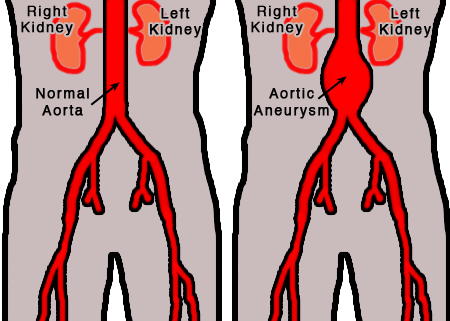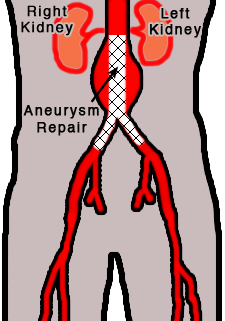
High blood pressure, high cholesterol, and smoking not only increase your risk for heart disease, but these same risk factors are also related to the development of potentially life-threatening
aortic aneurysms.
Your aorta is a large arterial blood vessel into which your heart pumps oxygenated blood. Your aorta moves upward from the heart, giving off branches of arteries that supply blood to the arms and the brain, before it turns downward to supply blood to your internal organs and eventually your legs.
An aortic aneurysm occurs when there is weakening of the aorta's wall, leading to dilation and expansion of the normal-sized aorta (see figure to the right). Much like a balloon that continues to be filled with air, the larger the aneurysm grows, the more likely that it will burst or rupture. A ruptured aortic aneurysm is a life-threatening condition that can be prevented with early detection, routine monitoring, and vascular repair when necessary.
BCS Heart provides services for the diagnosis, management, and minimally invasive treatment of aortic aneurysms. For additional information, and to see if you may benefit from these services, contact your doctor at BCS Heart.

Although some aortic aneurysms require an invasive surgery to treat, many patients may benefit from a less invasive approach offerred by BCS Heart. This procedure involves the use of specialized catheters and is summarized below.
Following patient sedation, usually in an operating room or similar setting, catheters are inserted through the legs/groin and an endovascular graft (pipe-shaped structure) is placed across the aneurysm (see figure to the right).
The graft serves to rebuild and protect the weakened aorta from bursting or rupture. Blood flow now can pass through the new graft to the legs without dangerous pressure being placed on the dilated aorta.
Recovery from this minimally invasive procedure is rapid and patients usually can return home within 1-2 days following the procedure.
For additional information regarding abdominal aortic aneurysm screening, management, and minimally invasive repair, please ask your doctor at BCS Heart.

 High blood pressure, high cholesterol, and smoking not only increase your risk for heart disease, but these same risk factors are also related to the development of potentially life-threatening aortic aneurysms.
High blood pressure, high cholesterol, and smoking not only increase your risk for heart disease, but these same risk factors are also related to the development of potentially life-threatening aortic aneurysms.
 Although some aortic aneurysms require an invasive surgery to treat, many patients may benefit from a less invasive approach offerred by BCS Heart. This procedure involves the use of specialized catheters and is summarized below.
Although some aortic aneurysms require an invasive surgery to treat, many patients may benefit from a less invasive approach offerred by BCS Heart. This procedure involves the use of specialized catheters and is summarized below.